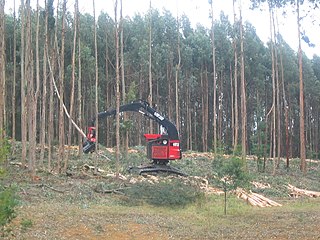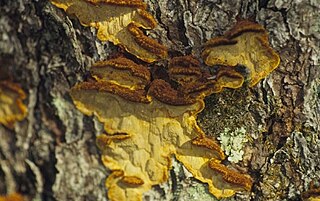
Wood is a structural tissue found in the stems and roots of trees and other woody plants. It is an organic material – a natural composite of cellulose fibers that are strong in tension and embedded in a matrix of lignin that resists compression. Wood is sometimes defined as only the secondary xylem in the stems of trees, or it is defined more broadly to include the same type of tissue elsewhere such as in the roots of trees or shrubs. In a living tree it performs a support function, enabling woody plants to grow large or to stand up by themselves. It also conveys water and nutrients between the leaves, other growing tissues, and the roots. Wood may also refer to other plant materials with comparable properties, and to material engineered from wood, or woodchips or fiber.

The longleaf pine is a pine species native to the Southeastern United States, found along the coastal plain from East Texas to southern Virginia, extending into northern and central Florida. In this area it is also known as "yellow pine" or "long leaf yellow pine", although it is properly just one out of a number of species termed yellow pine. It reaches a height of 30–35 m (98–115 ft) and a diameter of 0.7 m (28 in). In the past, before extensive logging, they reportedly grew to 47 m (154 ft) with a diameter of 1.2 m (47 in). The tree is a cultural symbol of the Southern United States, being the official state tree of Alabama. Contrary to popular belief, this particular species of pine is not officially the state tree of North Carolina.

Pulpwood is timber with the principal use of making wood pulp for paper production.

Pinus elliottii, commonly known as slash pine, is a conifer tree native to the Southeastern United States. Slash pine is named after the "slashes" – swampy ground overgrown with trees and bushes – that constitute its habitat. Other common names include swamp pine, yellow slash pine, and southern Florida pine. Slash pine has two different varieties: P. e. var. elliottii and P. e. var. densa. Historically, slash pine has been an important economic timber for naval stores, turpentine, and resin. The wood of slash pine is known for its unusually high strength, especially for a pine. It exceeds many hardwoods and is even comparable to very dense woods such as ironwood.

Weymouth Woods-Sandhills Nature Preserve is a North Carolina state park in Moore County, North Carolina in the United States. Located near Southern Pines, North Carolina, it covers 915 acres (3.70 km2) in the Sandhills region of the state.

The Sandhills or Carolina Sandhills is a 10-35 mi wide physiographic region within the U.S. Atlantic Coastal Plain province, along the updip (inland) margin of this province in the states of North Carolina, South Carolina, and Georgia. The extent of the Carolina Sandhills is shown in maps of the ecoregions of North Carolina, South Carolina, and Georgia.

In trees, heart rot is a fungal disease that causes the decay of wood at the center of the trunk and branches. Fungi enter the tree through wounds in the bark and decay the heartwood. The diseased heartwood softens, making trees structurally weaker and prone to breakage. Heart rot is a major factor in the economics of logging and the natural growth dynamic of many older forests. Heart rot is prevalent throughout the world affecting all hardwood trees and can be very difficult to prevent. A good indication of heart rot is the presence of mushrooms or fungus conks on the tree.

Terminalia elliptica is a species of Terminalia native to southern and southeast Asia in India, Nepal, Bangladesh, Myanmar, Thailand, Laos, Cambodia, and Vietnam. It is a prominent part of both dry and moist deciduous forests in southern India up to 1000 m.

Fatwood, also known as "fat lighter", "lighter wood", "rich lighter", "pine knot", "lighter knot", "heart pine", "fat stick" or "lighter'd" [sic], is derived from the heartwood of pine trees. The stump that is left in the ground after a tree has fallen or has been cut is the primary source of fatwood, as the resin-impregnated heartwood becomes hard and rot-resistant after the tree has died. Wood from other locations can also be used, such as the joints where limbs intersect the trunk. Although most resinous pines can produce fatwood, in the southeastern United States the wood is commonly associated with longleaf pine, which historically was highly valued for its high pitch production.

Phellinus pini is a fungal plant pathogen that causes tree disease commonly known as "red ring rot" or "white speck". This disease, extremely common in the conifers of North America, decays tree trunks, rendering them useless for lumber. It is a rot of the heartwood. Signs of the fungus include shelf-shaped conks protruding from the trunks of trees. Spores produced on these conks are blown by the wind and go on to infect other trees. Formal management of this disease is limited, and the disease is controlled primarily by cultural practices. Red ring rot is an important forest disturbance agent and plays a key role in habitat formation for several forest animals.

A tree hollow or tree hole is a semi-enclosed cavity which has naturally formed in the trunk or branch of a tree. They are found mainly in old trees, whether living or not. Hollows form in many species of trees, and are a prominent feature of natural forests and woodlands, and act as a resource or habitat for a number of vertebrate and invertebrate animals.

Reclaimed lumber is processed wood retrieved from its original application for purposes of subsequent use. Most reclaimed lumber comes from timbers and decking rescued from old barns, factories and warehouses, although some companies use wood from less traditional structures such as boxcars, coal mines and wine barrels. Reclaimed or antique lumber is used primarily for decoration and home building, for example for siding, architectural details, cabinetry, furniture and flooring.

Ramial chipped wood (RCW), also called BRF, is a type of woodchips made solely from small to medium-sized branches. The adjective "ramial" refers to branches (rami). RCW is a forest product used in agriculture for mulching and soil enrichment. It may be laid on top of the soil, mixed into it, or composted first and then applied.

The eastern woodlands of the United States covered large portions of the southeast side of the continent until the early 20th century. These were in a fire ecology of open grassland and forests with low ground cover of herbs and grasses.

Pre-Columbian woodlands of North America, consisting of a mixed woodland-grassland ecosystem, were maintained by both natural lightning fires and by Native Americans before the significant arrival of Europeans. Although decimated by widespread epidemic disease, Native Americans in the 16th century continued using fire to clear woodlands until European colonists began colonizing the eastern seaboard. Many colonists continued the practice of burning to clear underbrush, reinforced by their similar experience in Europe, but some land reverted to forest.

Diospyros sandwicensis is a species of flowering tree in the ebony family, Ebenaceae, that is endemic to Hawaii. It belongs to the same genus as both persimmons and ebony. Its common name, lama, also means enlightenment in Hawaiian. Lama is a small to medium-sized tree, with a height of 6–12 m (20–39 ft) and a trunk diameter of 0.3 m (0.98 ft). It can be found in dry, coastal mesic, mixed mesic, and wet forests at elevations of 5–1,220 m (16–4,003 ft) on all major islands. Lama and olopua are dominant species in lowland dry forests on the islands of Maui, Molokaʻi, Kahoʻolawe, and Lānaʻi.

The Longleaf pine Ecosystem is a climax savanna habitat found within the Southern United States; it includes many rare plant and animal species, and is one of the most biodiverse in North America. Once the largest ecosystem in North America, it now occupies less than a quarter of the original range. Degradation of the ecosystem is partially due to excessive timber harvesting, urbanization, and fire exclusion. Although the ecosystem is heavily fragmented at present, it still carries a great diversity of plant and animal species, many of which are endemic. A range of techniques, including planting longleaf pine seedlings, introducing prescribed burning regimens, managing native ground cover, and controlling invasive species within the ecosystem, are used in attempting to preserve this threatened ecosystem.

Bilinga is an African wood, from Nauclea diderrichii trees in the family Rubiaceae.
Dalbergia stevensonii, also called Honduras rosewood, is a Central American tree species in the legume family. It grows in broadleaf evergreen swamp forests in southern Belize and adjacent Guatemala and Mexico. The wood is highly valuable, which has led to population loss from illegal logging.

Palustris Experimental Forest is an experimental forest operated by the Southern Research Station (SRS) of the United States Forest Service in Rapides Parish, Louisiana. It is located south of Alexandria, Louisiana within the Kisatchie National Forest. The experimental forest bears the name of the predominant pine species that covered this region before the virgin pine forests were harvested in the early 1900s.


















